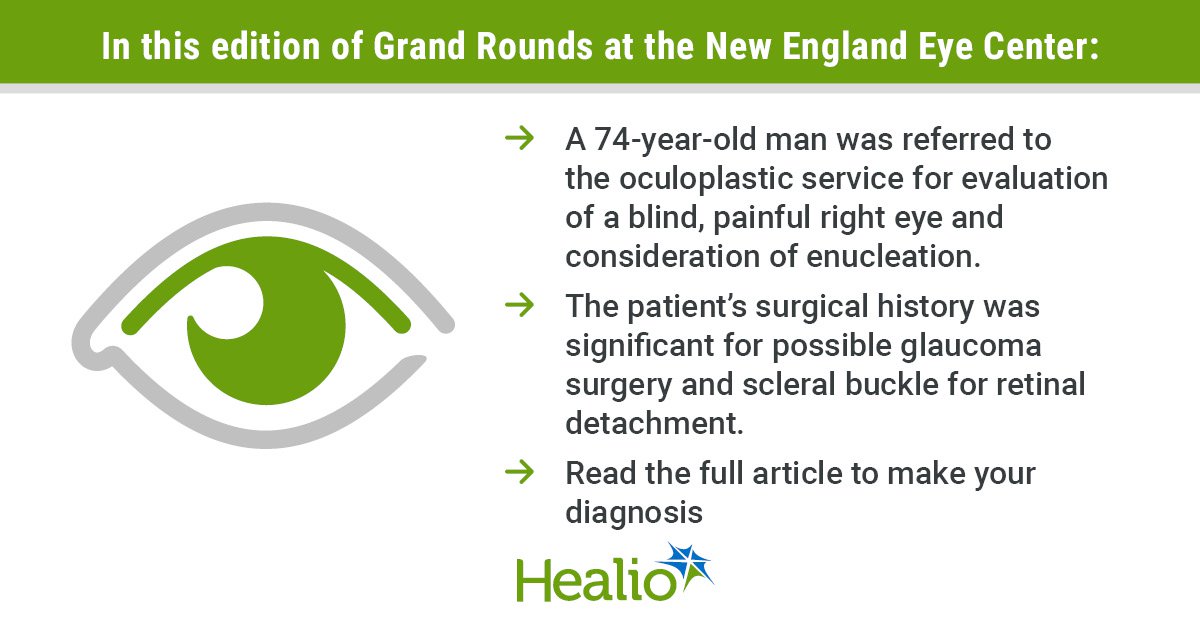October 07, 2025
5 min read
A 74-year-old man was referred to the oculoplastic service at Tufts Medical Center/New England Eye Center for evaluation of a blind, painful right eye and consideration of enucleation.
The patient had a medical history of hypertension, diabetes and prostate cancer treated with radiation and an ocular history of retinal detachment in the right eye, primary open-angle glaucoma in the left eye and cataracts in both eyes. His surgical history was significant for possible glaucoma surgery in the right eye and scleral buckle in the right eye for his retinal detachment in 1996. Prior surgical records were unavailable for review, and the patient did not remember the details of these surgeries. The patient noted that he had right upper eyelid swelling with decreased vision since his surgery in 1996. Over the last few years, the eyelid swelling was worsening with new increasing eye pain.

Examination
Ophthalmologic exam revealed best corrected visual acuities of no light perception in the right eye and 20/40-2 in the left eye.
External examination showed right-sided tense orbitopathy with a significant firm superotemporal mass. Conjunctival and scleral exam in the right eye revealed a scleral buckle that was mostly covered with conjunctiva. However, there was nasal conjunctival breakdown with concern for mild extrusion of the previously implanted scleral buckle. Corneal exam in the right eye showed phthisis with significant corneal edema with Descemet folds, endothelial pigment and central band keratopathy. There was no view to the other ocular structures in the right eye. Examination in the left eye showed mild swelling and erythema of the upper and lower lid along with 2+ nuclear sclerotic cataract. Otherwise, ocular examination in the left eye was normal.

Source: Victoria S. North, MD, and Varsha Pramil, MD
MRI of the orbits with and without contrast showed a right tubular structure with mild enhancement (Figure 1). B-scan ultrasonography showed concern for disorganized intraocular contents (Figure 2).

What is your diagnosis?
See answer below.
Blind, painful eye
External examination of the patient showing right-sided firm superotemporal upper eyelid swelling in a blind, painful eye raised concern for an expanding benign or malignant mass or structure.


An MRI of the orbits with and without contrast was obtained to better distinguish between these diagnoses. The imaging confirmed that this patient’s symptoms and exam findings were a consequence of an enlarging structure — a MIRAgel scleral buckle (MIRA) initially placed in 1996 that has continued to expand for almost 30 years and is now causing breakdown of the conjunctiva.
Clinical course
A right orbitotomy with extraction of the MIRAgel was strongly recommended at initial examination, and the patient was counseled on risk for infection with delayed surgery. The patient chose to delay surgery. Four months later, a repeat MRI of the orbits showed no changes. At that time, the patient’s right eye pain had worsened, and he agreed to proceed with surgery. On the day of surgery, copious purulent discharge was seen in the right eye. The decision was made with the patient’s agreement to move forward with a right orbitotomy and extraction of the MIRAgel scleral buckle with possible enucleation.


During surgery, the MIRAgel scleral buckle was found to be extruding through the superior and nasal conjunctiva in the right eye. The MIRAgel was gently aspirated using a freer elevator. For parts of the MIRAgel scleral buckle that were deeper into the globe, a cryoprobe was used for removal. Further examination showed that the scleral buckle had eroded into the sclera and confirmed that the globe was violated and not salvageable. Therefore, enucleation of the right eye was performed. A dermis fat graft was harvested from above the rectus abdominus wall sheath and placed into the right globe socket anteriorly to replace orbital volume after enucleation. Overall, the surgery went well with no complications, and the patient was brought to the recovery room in stable condition. Cultures taken before surgery grew mixed respiratory flora and confirmed infection.
At the patient’s 2-month postoperative visit, he was recovering appropriately with pink and healthy conjunctiva and a viable fat dermis graft with no evidence of infection.
Discussion
Scleral buckles have been used as treatment for rhegmatogenous retinal detachments for many years. The goal of a scleral buckle is to push the choroid against the retina in order to bring the detached retina closer to the retinal pigment epithelium/sclera and seal all retinal breaks and prevent recurrent retinal detachments. Many types of scleral buckles have been created. Currently, scleral buckles made from silicone are most widely used.
The MIRAgel scleral buckle was introduced in 1976. It was developed from hydrogel, a nontoxic and nonantigenic material. Hydrogel was thought to be an excellent option because of its ability to be easily sterilized and molded into any shape. It was also permeable to water so it could be penetrated by water-soluble antibiotics and increase in size when placed in an aqueous medium. When the MIRAgel scleral buckle was placed in the eye, it was thought that the hydrogel would become hydrated and expand, reaching its maximum size about 1 year after placement. As it enlarged, the buckle would better reinforce the sclera to the retina.
However, as the hydrogel hydrolyzed, it continued to expand even many years after placement. Eight to 10 years after MIRAgel scleral buckles were implanted, many complications became apparent, ranging from mild conjunctival protrusion and eyelid edema to erosion of the scleral buckle into the globe. All were due to unforeseen continued swelling of the MIRAgel scleral buckle. In some cases in which medical records were difficult to access and there was no known scleral buckle implantation, these findings were even mistaken for an orbital tumor and required further imaging and/or biopsy.
Ultimate treatment of these symptoms requires removal of the implant. Most common reasons for removal include pain, cosmesis concerns, ocular motility disorders, diplopia, infection, and intraocular or extraocular migration of the implant. Unfortunately, removal of the MIRAgel scleral buckle can be difficult. The hydration of the hydrogel material not only causes it to swell but it also changes its consistency from a soft, compact material to a gel-like, friable substance. The friability makes the buckle difficult to grab with forceps and remove as one piece. Methods such as using a cryoprobe or suction catheters have been found to be successful. If there has been intraocular migration, fragmatome ultrasound can be used for intravitreal fragmentation and removal. Evisceration or enucleation is recommended only in cases of a blind, painful eye.
In this case, the patient presented with a blind, painful right eye due to an expanding MIRAgel scleral buckle placed almost 30 years prior. The scleral buckle migrated into the globe with mild extrusion into the conjunctiva and caused a periocular infection necessitating enucleation of the right eye. This clinical scenario highlights the important point that MIRAgel scleral buckles can cause ocular complications many years after placement and may need to be surgically removed.
- For more information:
- Victoria S. North, MD, of New England Eye Center, Tufts University School of Medicine, can be reached at victoria.north@tuftsmedicine.org.
- Varsha Pramil, MD, of New England Eye Center, Tufts University School of Medicine, can be reached at varsha.pramil@tuftsmedicine.org.
- Edited by James T. Kwan, MD, and Heba Mahjoub, MD, of New England Eye Center, Tufts University School of Medicine. They can be reached at james.kwan.ophthalmology@gmail.com and hmahjoub@tuftsmedicalcenter.org.










